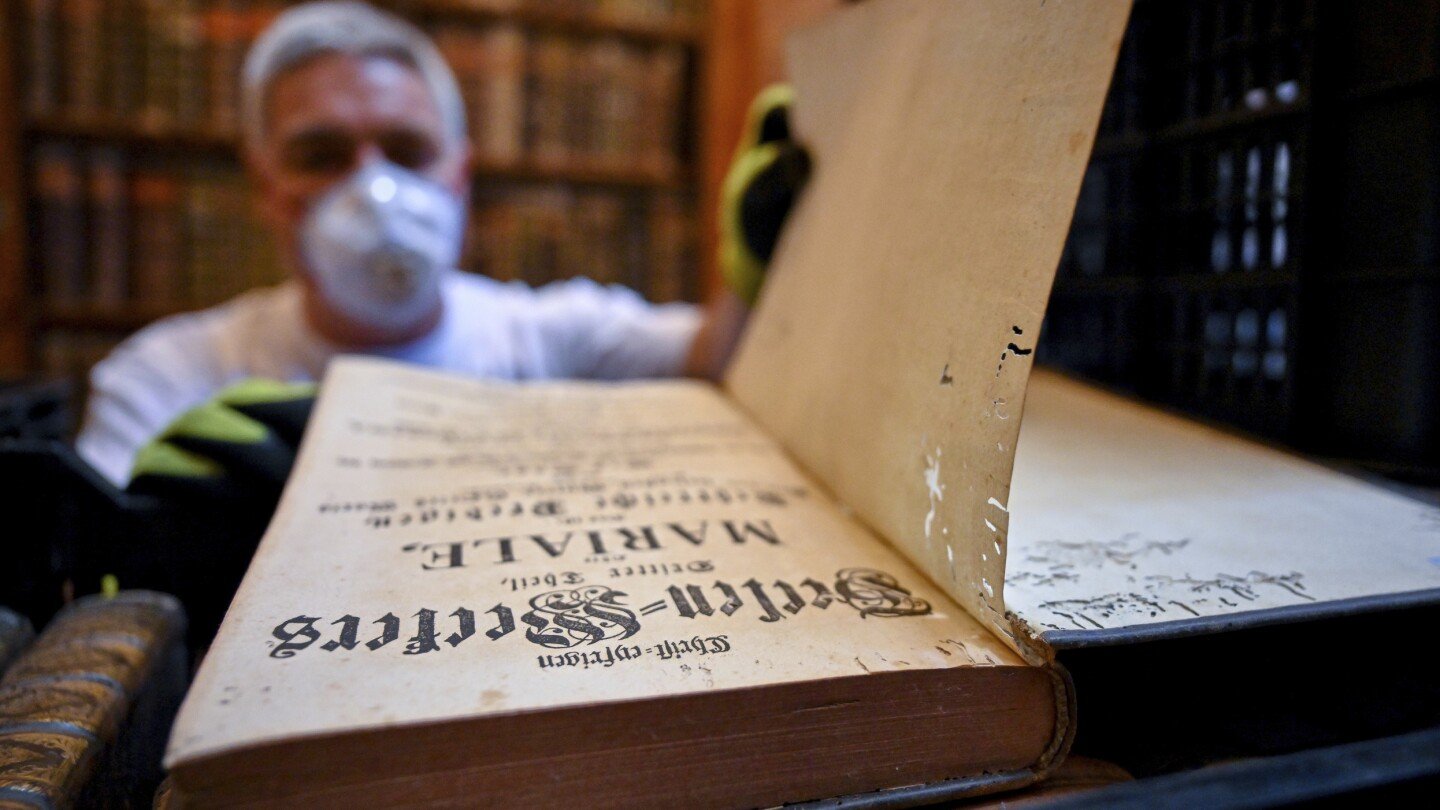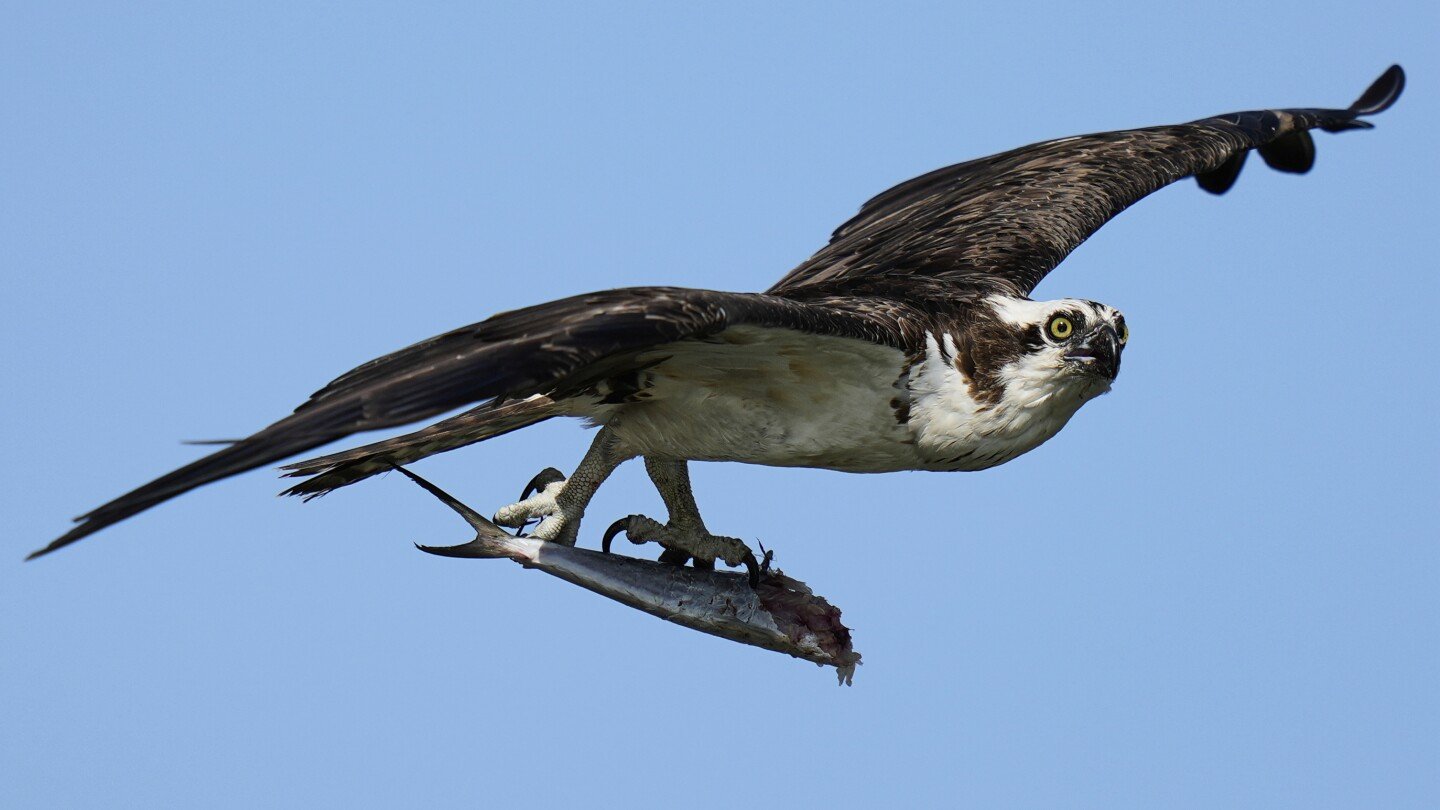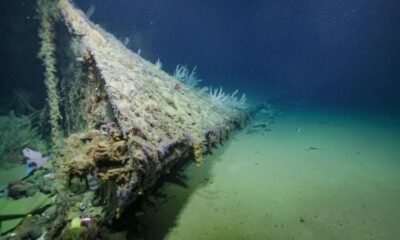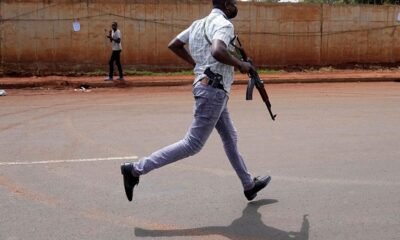Lifestyle
Trump’s big bill cuts Medicaid, SNAP: How it could affect babies

WASHINGTON (AP) — The impact of the massive spending bill that President Donald Trump signed into law on Independence Day is expected to filter down to infants and toddlers — a segment of the population that is particularly vulnerable to cuts to the federal social safety net.
Many middle-class and wealthy families will see benefits from the new legislation, but programs that help low-income families keep babies healthy have been cut back. While state money funds public schools and preschool in some cases, programs supporting the youngest children are largely backed by the federal government.
The law extends tax cuts that Trump passed during his first term in office and pours billions more into border security as the president seeks to broaden his crackdown on immigration. To pay for these initiatives, the law cuts Medicaid and food stamps — programs relied upon by poor households with children — by more than $1 trillion.
The legislation Republicans called Trump’s “big beautiful bill” is set to deliver some gains for families with children. It increases tax credits, including one that now allows parents to deduct up to $2,200 per child from their tax bills. And it introduces investment accounts for newborns dubbed “Trump Accounts,” each seeded with $1,000 from the government.
Still, advocates say they do not make up for what children are likely to lose under the new law. And they fear what comes next, as the next Trump budget proposes more cuts to programs that help parents and babies.
Medicaid cuts could add to strains on families
Over 10 million Americans rely on Medicaid for health care. About 40% of births are covered by Medicaid. Newborns, too, qualify for it when their mothers have it.
The new law doesn’t take little kids or their parents off Medicaid. It institutes Medicaid work requirements for childless adults and adults with children over the age of 13. But pediatricians warn the cuts will be felt broadly, even by those who do not use Medicaid.
The Medicaid cuts are expected to put a financial strain on health care providers, forcing them to cut their least profitable services. That’s often pediatrics, where young patients are more likely to use Medicaid, said Lisa Costello, a West Virginia pediatrician who chairs the federal policy committee for the American Association of Pediatrics.
The ripple effects could exacerbate an existing shortage of pediatricians and hospital beds for children.
“Any cuts to that program are going to trickle down and impact children, whether that’s pediatric practices who depend on Medicaid to be able to stay open or children’s hospitals,” Costello said.
States also use Medicaid to pay for programs that go beyond conventional medical care, including therapies for young children with disabilities. Under the new law, states will foot a greater portion of the bill for Medicaid, meaning optional programs are at risk of getting cut.
Advocates worry that if an adult loses Medicaid coverage, it could ratchet up household stress and make it more difficult for parents to make ends meet, both of which can negatively impact youngsters. And parents who lose their health insurance are less likely to take their children to the doctor.
“When parents lose their health insurance, they often think that their children also are no longer eligible, even if that’s not the case,” said Cynthia Osborne, a professor of early education and the executive director of the Prenatal-to-3 Policy Impact Center at Vanderbilt University.
The law increases tax credits for parents who qualify
The law increases the child tax credit to $2,200 per child, up from $2,000. But parents who don’t earn enough to pay income tax will still not see the benefit, and many will only see a partial benefit.
The measure also contains two provisions intended to help families pay for child care, which in many places costs more than a mortgage. First, it boosts the tax credit parents receive for spending money on child care. The bill also expands a program that gives companies tax credits for providing child care for their employees.
Both measures have faced criticism for generally benefiting larger companies and wealthier households.
“It’s a corporate business tax break,” said Bruce Lesley, president of the advocacy group First Focus on Children. “It makes their child care dependent upon working for an employer who has the credit.”
‘Trump Accounts’ will be opened with $1,000 for newborns
The law launches a program that creates investment accounts for newborn children. The “Trump Accounts” are to be seeded with $1,000 from the government, and children will be able to use the money when they become adults to start a new business, put the money toward a house or go to school.
Unlike other baby bond programs, which generally target disadvantaged groups, the federal program will be available to families of all incomes.
The program’s backers have pitched the accounts as a way to give young people a boost as they reach adulthood and teach them about the benefits of investing. Critics have argued that families in poverty have more immediate needs and that their children should receive a larger endowment if the goal is to help level the playing field.
A food assistance program faces cuts
The Supplemental Nutrition Assistance Program (SNAP) faces the largest cut in its history under the law. It will, for the first time, require parents to work to qualify for the benefit if their children are 14 or older. But even households with younger children could feel the impact.
The law kicks some immigrants — including those with legal status — off food assistance. It makes it more difficult for individuals to qualify by changing how it considers their utility bills.
SNAP has historically been funded by the federal government, but under the new law, states will have to shoulder some of the financial burden. Cash-strapped governments could decide to implement new requirements that would make it more difficult for people to qualify, said Katie Bergh, a senior policy analyst with the Center on Budget and Policy Priorities. Some states may decide to exit the program altogether.
“When young children lose access to that healthy nutrition, it impacts them for the rest of their lives,” Bergh said. “This bill fundamentally walks away from a long-standing nationwide commitment to making sure that low-income children in every state can receive the food assistance that they need.”
___
The Associated Press’ education coverage receives financial support from multiple private foundations. AP is solely responsible for all content. Find AP’s standards for working with philanthropies, a list of supporters and funded coverage areas at AP.org.
Lifestyle
Hungary’s oldest library is fighting to save 100,000 books from a beetle infestation

PANNONHALMA, Hungary (AP) — Tens of thousands of centuries-old books are being pulled from the shelves of a medieval abbey in Hungary in an effort to save them from a beetle infestation that could wipe out centuries of history.
The 1,000-year-old Pannonhalma Archabbey is a sprawling Benedictine monastery that is one of Hungary’s oldest centers of learning and a UNESCO World Heritage site.
Restoration workers are removing about 100,000 handbound books from their shelves and carefully placing them in crates, the start of a disinfection process that aims to kill the tiny beetles burrowed into them.
The drugstore beetle, also known as the bread beetle, is often found among dried foodstuffs like grains, flour and spices. But they also are attracted to the gelatin and starch-based adhesives found in books.
They have been found in a section of the library housing around a quarter of the abbey’s 400,000 volumes.
“This is an advanced insect infestation which has been detected in several parts of the library, so the entire collection is classified as infected and must be treated all at the same time,” said Zsófia Edit Hajdu, the chief restorer on the project. “We’ve never encountered such a degree of infection before.”
Abbey houses historical treasures
The beetle invasion was first detected during a routine library cleaning. Employees noticed unusual layers of dust on the shelves and then saw that holes had been burrowed into some of the book spines. Upon opening the volumes, burrow holes could be seen in the paper where the beetles chewed through.
The abbey at Pannonhalma was founded in 996, four years before the establishment of the Hungarian Kingdom. Sitting upon a tall hill in northwestern Hungary, the abbey houses the country’s oldest collection of books, as well as many of its earliest and most important written records.
For over 1,000 years, the abbey has been among the most prominent religious and cultural sites in Hungary and all of Central Europe, surviving centuries of wars and foreign incursions such as the Ottoman invasion and occupation of Hungary in the 16th century.
Ilona Ásványi, director of the Pannonhalma Archabbey library, said she is “humbled” by the historical and cultural treasures the collection holds whenever she enters.
“It is dizzying to think that there was a library here a thousand years ago, and that we are the keepers of the first book catalogue in Hungary,” she said.
Among the library’s most outstanding works are 19 codices, including a complete Bible from the 13th century. It also houses several hundred manuscripts predating the invention of the printing press in the mid-15th century and tens of thousands of books from the 16th century.
While the oldest and rarest prints and books are stored separately and have not been infected, Ásványi said any damage to the collection represents a blow to cultural, historical and religious heritage.
“When I see a book chewed up by a beetle or infected in any other way, I feel that no matter how many copies are published and how replaceable the book is, a piece of culture has been lost,” she said.
Books will spend weeks in an oxygen-free environment
To kill the beetles, the crates of books are being placed into tall, hermetically sealed plastic sacks from which all oxygen is removed. After six weeks in the pure nitrogen environment, the abbey hopes all the beetles will be destroyed.
Before being reshelved, each book will be individually inspected and vacuumed. Any book damaged by the pests will be set aside for later restoration work.
Climate change may have contributed
The abbey, which hopes to reopen the library at the beginning of next year, believes the effects of climate change played a role in spurring the beetle infestation as average temperatures rise rapidly in Hungary.
Hajdu, the chief restorer, said higher temperatures have allowed the beetles to undergo several more development cycles annually than they could in cooler weather.
“Higher temperatures are favorable for the life of insects,” she said. “So far we’ve mostly dealt with mold damage in both depositories and in open collections. But now I think more and more insect infestations will appear due to global warming.”
The library’s director said life in a Benedictine abbey is governed by a set of rules in use for nearly 15 centuries, a code that obliges them to do everything possible to save its vast collection.
“It says in the Rule of Saint Benedict that all the property of the monastery should be considered as of the same value as the sacred vessel of the altar,” Ásványi said. “I feel the responsibility of what this preservation and conservation really means.”
Lifestyle
Osprey are declining and environmentalists blame fishing industry’s take of menhaden

GLOUCESTER POINT, Va. (AP) — Stepping onto an old wooden duck blind in the middle of the York River, Bryan Watts looks down at a circle of sticks and pine cones on the weathered, guano-spattered platform. It’s a failed osprey nest, taken over by diving terns.
“The birds never laid here this year,” said Watts, near the mouth of Virginia’s Chesapeake Bay. “And that’s a pattern we’ve been seeing these last couple of years.”
An osprey is silhouetted as it perches atop a nest on the Lynnhaven River, June 30, 2025, in Virgina Beach, Va. (AP Photo/Stephanie Scarbrough)
Watts has a more intimate relationship with ospreys than most people have with a bird — he has climbed to their nests to free them from plastic bags, fed them by hand and monitored their eggs with telescopic mirrors.
The fish-eating raptor known for gymnastic dives and whistle-like chirps is an American conservation success story. After pesticides and other hazards nearly eliminated the species from much of the country, the hawk-like bird rebounded after the banning of DDT in 1972 and now numbers in the thousands in the U.S.
An osprey flies with a half-eaten fish in its talons above the Lynnhaven River, June 30, 2025, in Virginia Beach, Va. (AP Photo/Stephanie Scarbrough)
But Watts has documented an alarming trend. The birds, which breed in many parts of the U.S., are failing to successfully fledge enough chicks around their key population center of the Chesapeake Bay. The longtime biologist blames the decline of menhaden, a small schooling fish critical to the osprey diet. Without menhaden to eat, chicks are starving and dying in nests, Watts said.
Osprey are an environmental indicator
Watts’s claim has put him and environmental groups at odds with the fishing industry, trade unions and sometimes government regulators. Menhaden is valuable for fish oil, fish meal and agricultural food as well as bait.
U.S. fishermen have caught at least 1.1 billion pounds of menhaden every year since 1951. Members of the industry tout its sustainability and said the decline in osprey may have nothing to do with fishing.
But without help, the osprey population could tumble to levels not seen since the dark days of DDT, said Watts, director of the Center for Conservation Biology at The College of William & Mary in Williamsburg, Virginia.
Brian Watts, research professor and director of the Center for Conservation Biology at The College of William & Mary, looks over at failed osprey nest atop a wooden duck blind on the Lower York River, June 30, 2025, in Gloucester Point, Va. (AP Photo/Stephanie Scarbrough)
“The osprey are yelling pretty loudly that, hey, there’s not enough menhaden for us to reproduce successfully,” Watts said. “And we should be listening to them to be more informed fully on the fisheries side, and we should take precaution on the fisheries management side. But that hasn’t won the day at this point.”
Decline linked to menhaden in studies
Watts, who has studied osprey on the Chesapeake for decades, has backed his claims of population decline by publishing studies in scientific journals. He said it boils down to a simple statistic — to maintain population, osprey pairs need to average 1.15 chicks per year.
Osprey were reproducing at that level in the 1980s, but today in some areas around the main stem of the Chesapeake, it’s less than half of that, Watts said. In particularly distressed areas, they aren’t even reproducing at one-tenth that level, he said. And the decline in available menhaden matches the areas of nesting failure, Watts said.
A bald eagle, left, steals a fish from an osprey before it could feed above the Lynnhaven River, June 30, 2025, in Virginia Beach, Va. (AP Photo/Stephanie Scarbrough)
Also called pogies or bunkers, the oily menhaden are especially important for young birds because they are more nutritious than other fish in the sea. Osprey “reproductive performance is inextricably linked to the availability and abundance” of menhaden, Watts wrote in a 2023 study published in Frontiers in Marine Science.
Conservationists have been concerned for years, saying too many menhaden have been removed to maintain their crucial role in the ocean food chain. Historian H. Bruce Franklin went so far as to title his 2007 book on menhaden “The Most Important Fish In The Sea.”
Fishing industry pushes back
Menhaden help sustain one of the world’s largest fisheries, worth more than $200 million at the docks in 2023. Used as bait, the fish are critical for valuable commercial targets such as Maine lobster. They’re also beloved by sportfishermen.
The modern industry is dominated by Omega Protein, a Reedville, Virginia, company that is a subsidiary of Canadian aquaculture giant Cooke. The company pushed back at the idea that fishing is the cause of osprey decline, although it did acknowledge that fewer menhaden are showing up in some parts of the bay.
Federal data show osprey breeding is in decline in many parts of the country, including where menhaden is not harvested at all, said Ben Landry, an Omega spokesperson. Climate change, pollution and development could be playing a role, said Landry and others with the company.
Blaming fishing “just reeks of environmental special interest groups having an influence over the process,” Landry said.
New rules could be on the way
The menhaden fishery is managed by the Atlantic States Marine Fisheries Commission, an interstate body that crafts rules and sets fishing quotas. Prompted by questions about ospreys, it created a work group to address precautionary management of the species in the Chesapeake Bay.
A young osprey returns to its nest on the Lynnhaven River, June 30, 2025, in Virginia Beach, Va. (AP Photo/Stephanie Scarbrough)
In April, this group proposed several potential management approaches, including seasonal closures, restrictions on quotas or days at sea, and limitations on kinds of fishing gear. The process of creating new rules could begin this summer, said James Boyle, fishery management plan coordinator with the commission.
The osprey population has indeed shown declines in some areas since 2012, but it’s important to remember the bird’s population is much larger than it was before DDT was banned, Boyle said.
“There are big increases in osprey population since the DDT era,” Boyle said, citing federal data showing a six-fold increase in osprey populations along the Atlantic Coast since the 1960s.
Environmentalists says bird’s decline could worsen
To a number of environmental groups, any decline is too much. This irritates some labor leaders who worry about losing more jobs as the fishing industry declines.
Kenny Pinkard, retired vice president of UFCW Local 400’s executive board and a longtime Virginia fishermen, said he feels the industry is being scapegoated.
“There are some people who just don’t want to see us in business at all,” he said.
But Chris Moore, Virginia executive director for Chesapeake Bay Foundation, said the country risks losing an iconic bird if no action is taken. He said Watts’s studies show that the osprey will fail without access to menhaden.
“Osprey have been a success story,” Moore said. “We’re in a situation where they’re not replacing their numbers. We’ll actually be in a situation where we’re in a steep decline.”
___
Whittle reported from Portland, Maine.
___ This story was supported by funding from the Walton Family Foundation. The AP is solely responsible for all content.
Lifestyle
Cooling gadgets and wearables can help you beat the heat

You can only sit in front of the fridge with the door open for so long.
As heat waves blast the world like a blow dryer on high, folks are reaching for anything that promises a little personal chill: portable mini fans, cooling neck wraps, high-tech vests and all kinds of heat-beating headwear.
Of course, cooling gear helps most when paired with basic and safe strategies against the heat: most importantly hydration, shade and rest. Stay out of extreme heat when possible, and know the signs of heat exhaustion or heat stroke.
Yet these wearable wonders and breezy gadgets can offer some relief. They might look quirky, but when the AC struggles and the sidewalk feels like a stovetop, they can start to seem like must-haves.
When you’re at home
Indoors, stay comfy with cool-feel sheets (like those with a silky finish or lightweight fibers), bed fans (where a nozzle inserted into the bed linens pumps a flow of air around you), or a cooling pillow or chill pad, which are filled with a gel that can stay cool for hours. Sleep-product brands include Serta, Sealy, Casper, Pluto and Threshold.
The chill pads can work for your own bed and the pets’ bed too. There are chillable full-size mattresses (Chilipad, 8Sleep and BedJet get good reviews from The Spruce) and smaller, simple pads (CoolCare and Sharper Image, among others).
Outdoor wearables
Clare Epstein, an employee safety expert with Vector Solutions in Tampa, Florida, works to reduce heat stress for at-risk employees in industries like construction, aviation and agriculture. She recommends wearables like cooling scarves and evaporative cooling vests.
“By soaking the fabric in cold water at the beginning of the day, the vest slowly cools, and keeps the wearer cool,” she says.
Clothes made of “phase change materials,” or PCMs, contain gel capsules or pads that can help moderate body temperatures. Uline.com advertises a vest that stays under 60 degrees for a few hours, and AlphaCool offers a neck tube that performs similarly. Another feature of the tube, which is made of a polymer material, is that it doesn’t get overly chilled, so it’s safe for kids to use.
Also for kids, there’s a line of plush toys from Warmies that includes little critters of the farmyard, ocean, forest and safari that can be popped in the freezer before a trip to the park or playground.
Wearable items that incorporate small fans or thermoelectric coolers are also good, Epstein says. And there are vests with tubed reservoirs you can fill with water or electrolytes so you can sip as you go.
“These encourage people to take more water breaks, and stay hydrated,” says Epstein.
The wearables range is extensive. Along with cooling buffs, headbands, wristbands, socks and scarves, there are cooling brimmed hats and ball caps. Brands include Mission, Ergodyne, and Sunday Afternoon.
If you’d prefer a refreshing breeze, USB-chargeable handheld or wearable fans might do the job.
Chill advice
Lynn Campbell, co-founder of 10Adventures travel company in Calgary, Alberta, takes a lot of strenuous hiking and cycling trips with her husband, Richard. They’ve developed some easy hacks for hot days.
“We’ll wake up early, so we’re done by 10 or 11 a.m., or if we’re out on the trails, split the day in two, so we rest by water or in the shade over the hottest part” of the day, she says.
Wear light colors and thin, breathable fabrics.
And bring an umbrella. “This is a game-changer,” Campbell says. “Now we always pack ultralight, compact ones; they’re incredible.”
Also, pour cool water on your head and back. “We freeze a few bottles of water so we can pour ice water on us to cool down,” Campbell says. “Putting the bottles under the armpits, in the groin, or on the back of the neck can effectively cool a person down.”
And Annita Katee, a contributing writer for Apartment Therapy, has another way to prep your bed on hot nights:
“Pop your sheets into the freezer at least two hours before bedtime, then pull them out right before you hit the sack,” she wrote in a recent post. She folds hers into a zipped plastic bag, flattens it, then sets it on a freezer shelf between ice packs.
“The result? A delightfully cool bed that feels like a refreshing oasis against the heat.”
___
New York-based writer Kim Cook covers design and decor topics regularly for The AP. Follow her on Instagram at @kimcookhome.
For more AP Lifestyles stories, go to https://apnews.com/lifestyle
-

 Asia5 days ago
Asia5 days agoA torpedoed US Navy ship escaped the Pacific in reverse, using coconut logs. Its sunken bow has just been found
-

 Europe5 days ago
Europe5 days agoExtreme heat is a killer. A recent heat wave shows how much more deadly its becoming as humans warm the world
-

 Asia4 days ago
Asia4 days agoGujarat state: Bridge collapse kills 9 in India
-

 Europe4 days ago
Europe4 days agoTrump promised 200 deals by now. He’s gotten 3, and 1 more is getting very close
-

 Lifestyle3 days ago
Lifestyle3 days agoHealthy workday snacks include a smart mix of energy-boosters
-

 Africa4 days ago
Africa4 days ago“Shoot in the leg”: Ruto orders Kenyan police to curb protest vandalism
-

 Africa4 days ago
Africa4 days agoTop European court delivers series of damning rulings against Russia
-

 Lifestyle2 days ago
Lifestyle2 days agoOne Tech Tip: All the ways to unsubscribe, after ‘click-to-cancel’ was blocked




